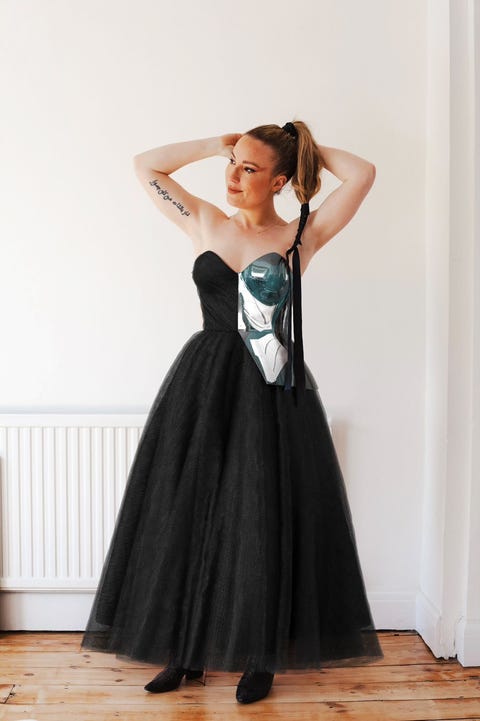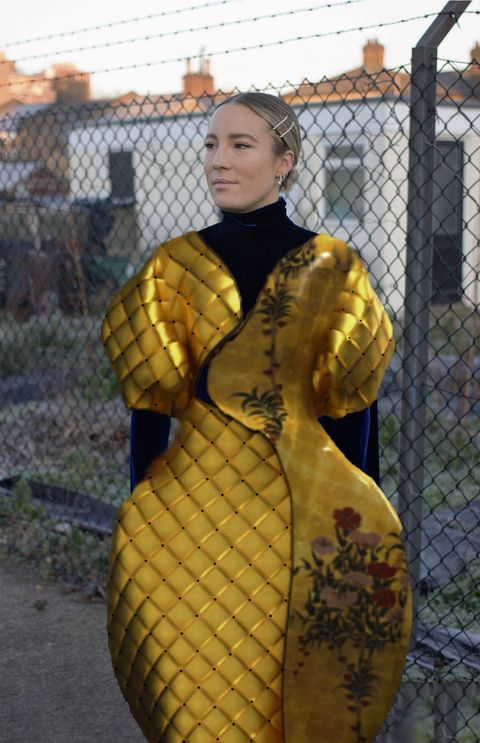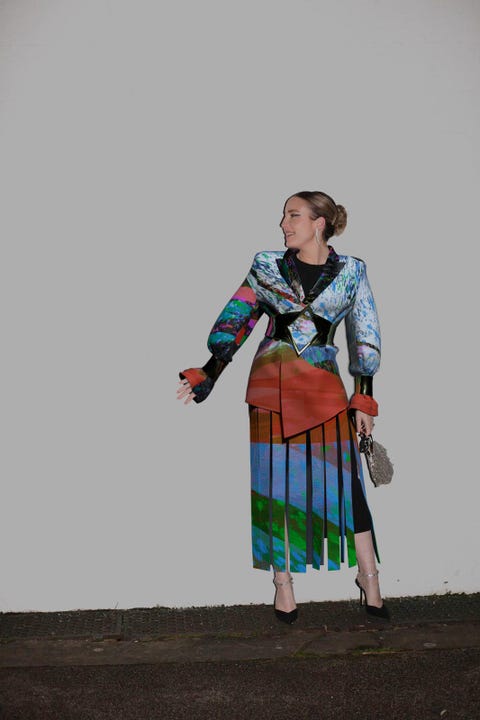
We earn a commission for products purchased through some links in this article.
I recognise the feeling. Serotonin pulsing through my bloodstream as I browse. It’s one of my favourite pastimes, scrolling e-commerce and rental sites for the perfect platform heel, or saving sheer tunics and feather-trimmed midis to wishlists for future events, both real and imaginary. And this particular purchase hits no different. The dress arrives and it’s a trip. The draping is masterful; the underskirt peeps coyly through delicate layers of tulle. The half-breastplate has an air of Zendaya in molten-gold Loewe at the Women in Film awards. I look like a queen. Appropriate, considering I opted for the ‘Intergalactic Royal Dress’. Granted, I probably would have styled it a bit differently if I’d known my feet were going to be on show. You see, this dress isn’t real. I sourced the outfit on virtual atelier Dressx, sent a barely clad photo of myself, and someone has superimposed the dress onto my body and delivered it back to my inbox. Its textiles are pixels, not anything tangible. But it is, in many ways, magnificent.

This isn’t my first flirtation with ‘phygital’ fashion – where the physical world blends with digital elements – or even fashion in the metaverse. I’m a millennial and a digital-native journalist, so my experience with AR goes well beyond Prada’s ‘Current Mood’ Instagram filter. I was never a gamer, but not because I find the idea unappealing. Quite the opposite – while relatively young, I recognised in myself a propensity to become quickly addicted to things, so stuck to cigarettes and alcohol or I’d have never left the house. But, every so often, I’ve dipped my toe into the gaming world and I appreciate the power of picking your player. The outback outlaw with the leopard-print muzzleloader for a day when you have lots of swagger; the sylph with a train of royal-blue chiffon to reflect your charm and status. Appearance in the virtual world is as emblematic of personality as it is in the physical; more so, because the possibilities for customisation are boundless.
'Appearance in the virtual world is as emblematic of personality as it is in the physical'

Even if not totally conscious of it, all of us move easily between digital personas. We dress for the ’gram, conduct work meetings over Teams, or video-call our pals in Dubai and, whether we choose to be a bouncing potato head, wear a pair of AR earrings or just blur out the background, we’re all making decisions about how to project ourselves online.
While I’ve slipped into various virtual realities, my relationship with digital fashion is complex. I have worked at a luxury fashion magazine for a long time and I adore clothes. The weight of a crinoline skirt (yes, I own one) is a remarkable thing. Empowering trousers are my belief system. And it still astounds me every time I’m lucky enough to get close to the artistry of haute couture. Perhaps I’m at that generational intersection where the allure of the digital world is irresistible, but there’s still scepticism about full immersion.
But as we begin to spend more time in virtual spaces, using everything from face-filler filters through to purely pixel ‘wearables’, what’s next? Some, like Ziqi Xing from digital-fashion lab Xtended Identity, imagine a future in which everything is either phygital or virtual, a screen’s lens augmenting all we do. That seems a long way off, though. Dressx’s Natalia Modenova and Daria Shapovalova, on the other hand, tell me that a ‘decentralised existence’ is more likely, where our physical state is just one facet of our identity, and our avatar dog wearing a Balenciaga hoodie in Fortnite might be a different, equally weighted, part of the whole.
'Even if not totally conscious of it, all of us move easily between digital personas'

Luke Bedford
I’m kind of on board with this from a fashion perspective. I am aware of my privilege in being able to access designer clothes, when most people don’t have the opportunity or the means. And if virtual dressing is democratising, in that it costs significantly less to purchase your dream designer ballgown (the one I bought was a mere £26), perhaps it’s possible for an avatar to be the expression of your best sartorial self. For those baulking at the idea that digital clothes could be on par with ‘real’ ones, I put this to you: the artistry that goes into constructing a beautiful virtual dress is no less impressive. From ideation sketches and trialling texture packs through to 3D modelling (the equivalent of a dressmaker’s toile) and rendering, it’s an intricate process. Luxury fashion brands such as Gucci, Iris van Herpen, Dundas and Coach have enlisted the help of virtual-world virtuosos including Republiqe, Dressx, GATE and Rook Vanguard to produce their metaverse designs. There are even digital tailors, such as Scotomalab, who have dedicated themselves exclusively to contriving majestic virtual fabrics.
It’s also more planet-friendly to live out our sartorial fantasies online. As virtual-fashion influencer Daniella Loftus’s Instagram disclaimer says: ‘No materials were harmed in the making of these photos.’ And Modenova stresses a digital dress is no less ‘real’ if it elicits emotions in the wearer, as it did for me.

All that said, there is one imminent innovation that stops me in my tracks: the creation of digital twins or digital passports for all of our physical clothes. For the uninitiated, tech companies are working on a way to turn all of our physical fashion items into NFTs – not in the sense of digital art (as might be your association with the term), but in that each tangible item will be issued with a corresponding one-of-a-kind digital token. It’s a virtual ‘twin’, which will carry unique, unreplicable information about it, stored indefinitely in the blockchain. By scanning a smart chip or QR code on your designer blazer, you’ll be able to access a whole sequence of data exclusive to that particular item, such as its material make-up and where in the world it was manufactured. You’ll carry ownership of it in your digital wallet and, if you sell the blazer, the digital twin will transfer to the new owner.
Major brands are already adopting the idea, which shows promise. We’ll be able to quickly determine authenticity, perhaps putting an end to the £1.4 trillion annually that’s fed into fashion fakes. Bottega Veneta has introduced NFC (near-field communication) tags into its bags for exactly this purpose, putting digital twins within grasping distance. Breitling watches already have full digital passports running on the blockchain, which can tell you about the watch’s care requirements and will soon let you see estimated resale value for future peer-to-peer trading. Digital twin NFTs may also be able to let you trace previous repairs, learn about responsible disposal, or confirm that Madonna did indeed once own this very coat. There are some ‘just for fun’ elements to the idea, too: Nike’s ‘Cryptokicks’ will let you breed your trainers’ NFT with somebody else’s, creating a cute, hybrid sneaker child that you can decide to have made physically, should you want to.
But despite all this novelty and usefulness, I worry about what we stand to lose. It seems to me that the value of every item will be immortalised according to a specific set of standards, involving age, provenance, restoration and resale price. By tethering it permanently to its digital passport, your designer blazer will only be worth the 12 years it has existed, plus one original garment bag minus two seam alterations. But in the digital future of fashion, is our value system always to be based on the cold statistics of tradeability?
blue squirrel fortnite

What about sentimentality and the more uncategorisable aspects of our emotional connections with clothes? I have a Gucci 1955 horsebit shoulder bag; a gift to myself after the birth of my son. It was a transactional acknowledgement of, to quote Radiohead, ‘everything in its right place’: career, finances, partner, child and personal fulfilment. I have had real feelings about virtual clothes, but they could never come close to my relationship with this bag. Just looking at it sparks immeasurable joy. I smile when I pick it up as it reminds me of all the goodness of the past few years, even as we’ve waded through tough times. I can’t put a number on that worth; you can’t encode those feelings in data. My Gucci bag’s online passport would say its value has depreciated over time as I’ve taken it on tequila-fuelled nights out and been clumsy with my spaghetti. It couldn’t possibly communicate that this is my life’s emotional zenith in bag form.
I have a green velvet jacket of my grandma’s. She was an actress, and I have visions of her treading the boards in it – and I look for stains that betray the parties after the performances. I don’t want to know the facts. A mixture of memory and imagination is what makes it magical. Dressx and Breitling have both insisted to me that blockchain is the future of heritage: you’ll be able to pass on your heirlooms via your digital wallet and, even better, they’ll continue to exist long after the physical item has disintegrated and gone, making memories like these eternal rather than ephemeral. But I feel like there’s a beauty in death, too. An important ritual is involved when savouring something that is taking its last gasps, even if we’re talking about a jacket or a bag.
'What about sentimentality and the more uncategorisable aspects of our emotional connections with clothes?'

There is genius and workmanship in digital fashion. I can endorse the idea that mainstream brands will launch ‘screenwear’ lines in the same way that they have festive collections and resortwear. Maybe virtually I’ll finally be able to afford a Saks Potts ‘Foxy’ coat. Avatars have huge worth if they allow us to express ourselves more wildly and freely than we sometimes feel able to do physically. Perhaps this is me subscribing to the idea of decentralisation. But it strikes me that there is still significance in the separation between our physical and our digital existences.
Some people love virtual reality so much that they’d prefer to experience everything through technology’s filter. And, certainly for fashion, digital twins might take us in that direction, with each physical item of clothing becoming inextricably entwined with its metaverse counterpart. But I am concerned that, if we do this, we risk blockchain value occluding any other kind of meaning our possessions might have for us. I prefer to think that we can immerse ourselves in the gorgeous fantasy of digital fashion while also having a life away from the screen, in which we protect the esoteric and deeply personal relationship we have with clothes. You can be a Roblox squirrel in Off-White jeans, showing off at a virtual concert, and later that day delve into a box at the back of the wardrobe to hold your grandmother’s jacket in silent reverence.
Natasha Bird Executive Editor (Digital) Natasha Bird is the Executive Editor (Digital) of ELLE.
